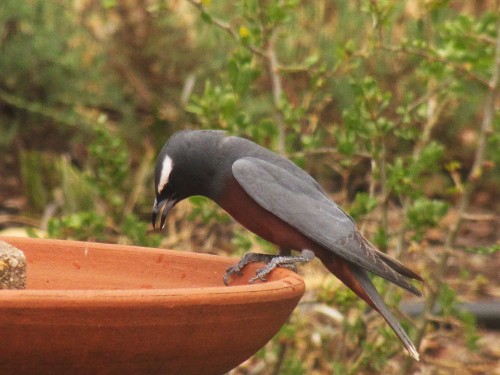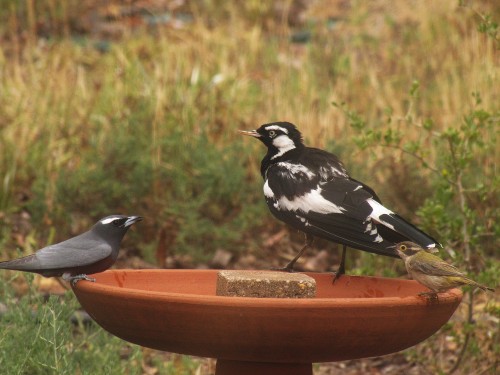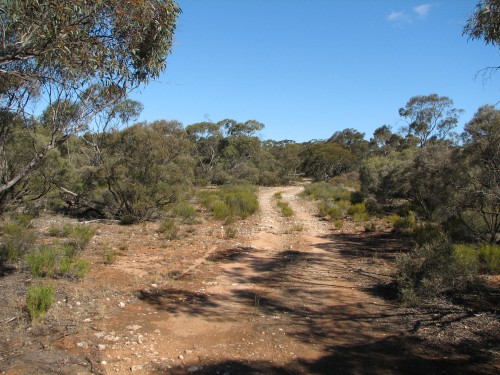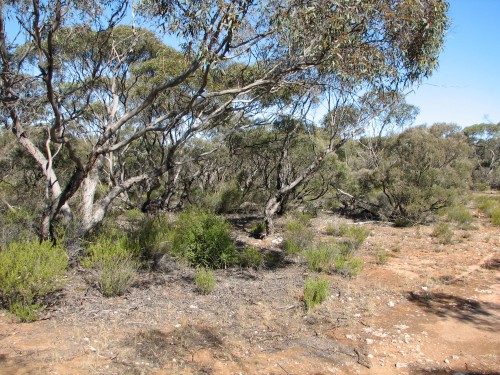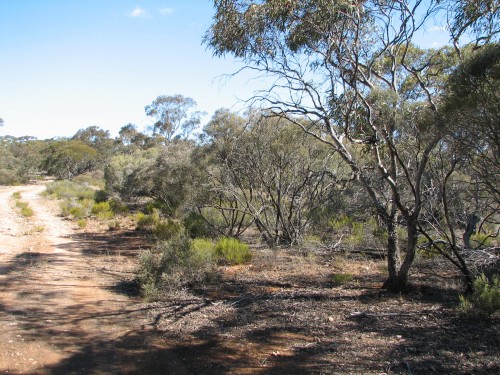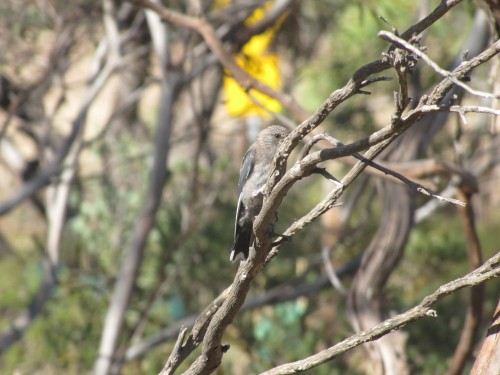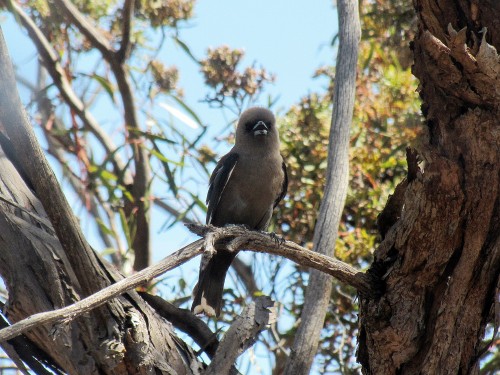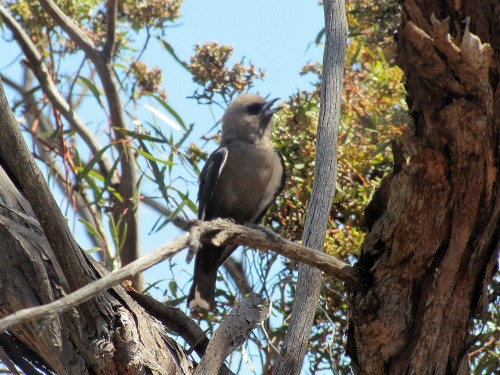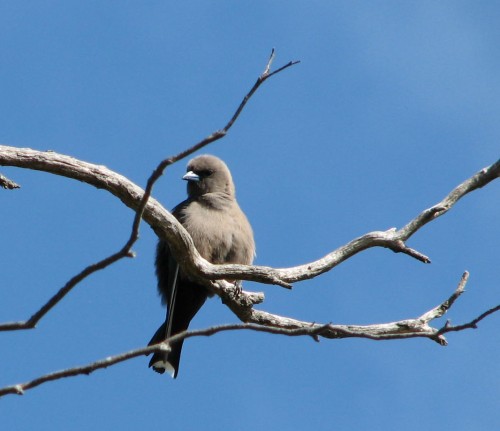White-browed Woodswallow at our bird bath
I must admit that I really enjoy seeing any of the six Australian species of woodswallows. On the downside, we only can expect to see three of those six species in our garden. To see the remaining three species I would have to travel several hundred kilometres to the north.
In fact, we only have fleeting visits from any of the woodswallows which occur in our area. They might hang around for a few minutes and then they are gone again. On most occasions I only see them swooping around high in the sky, presumably catching flying insects. On one special occasion two species flew in together and settled briefly – but long enough for photos.
Several weeks ago on one of the very hot days we are experiencing here in South Australia a solitary White-browed Woodswallow came to visit one of our bird baths – as recorded in the photos shown today. It was my wife who spotted it first and she was quite surprised; I don’t think that she had seen one up as close as this one. Because it was very thirsty it stayed around for quite a few minutes, long enough for me to take a good number of photos. At one stage it was not afraid to share the water with an Australian Magpie Lark (see below), a much larger species.
Further reading:
Birding in Lowan Conservation Park
A few Sundays ago we had a break in our cold, wintry weather and we went for a drive to Lowan Conservation Park, a 40 minute drive north east from home in Murray Bridge, South Australia. The park is about 15 kilometres south east of Bowhill. I had visited this park on several previous occasions and found that the birding can be either a feast or a famine; it all depends largely on what is in flower, or the weather conditions.
The park is predominantly mallee woodland (see photos) with a mixture of other smaller scrubs and bushes. My wife has written about some of the plants on her site here.
On our most recent visit I didn’t even bother to take any photos; I saw no birds to photograph, well, none within range. And while we had our picnic afternoon tea in the sun I heard very little. It was a real struggle to get a short list of birds – mostly heard. (PS The photos on this post were taken on another visit.)
Bird list:
- Little Raven
- Mallee Ringneck
- Grey Shrike-thrush
- Weebill
- White-winged Chough
- Singing Honeyeater
- Australian Magpie
- Grey Butcherbird
- Galah
- Grey Fantail
- Noisy Miner? (or Yellow-throated Miner? – I only heard them)
- Striated Pardalote
That is not a great list, but there was not much flowering. In a park of some 660 hectares one would expect far more honeyeaters, but the mallee has to be in flower. Honeyeater species I would expect to see – or already have seen on other occasions – include: Striped, White-fronted, White-eared, White-plumed, Spiny-cheeked, Purple-gaped, Yellow-plumed, Brown-headed, New Holland and Red Wattlebird.
In addition to the honeyeaters I would expect to see more parrots, pigeons, wrens, thornbills, chats, woodswallows, robins (I did see one, but it flew off before I could get a positive ID), owls, nightjars, frogmouths, swallows, cuckoos, eagles, kites, falcons and even a Malleefowl or two. I have seen two Chestnut Quail-thrush there many years ago; I hope that they are still around.
I guess that the best time to visit would be in the spring, when there is a chance of more flowers. I think that it might be worth camping there overnight. By the way – there is only a rough, stony and sometimes sandy track through the park and NO facilities at all.
Trevor
Further reading:
Juvenile Dusky Woodswallow
I was looking through some recent photos when I came across this one of a juvenile Dusky Woodswallow. I can’t fully remember the circumstances but I think it had just come to investigate the birdbath in our garden. I can’t recall if it actually had a drink or not, and it didn’t hang around for long.
Several species of woodswallow are seen from time to time in our garden or flying above. I didn’t see or hear any others on this particular occasion, though I was inside, probably with the early morning radio on in the background.
At first glance I was puzzled when I first saw this photo. The white tips on the tail give it away as a woodswallow as several of the species have white on the tail. The streaks on the head and neck indicate a juvenile, but the white strip on the leading edge of the wing indicates that it is a Dusky Woodswallow.
To take a closer look at the photo, click on the image to enlarge and then click on the View Original tab.
Dusky Woodswallow
I took this series of photos during one of our periods of heat waves recently. As I’ve written in recent days, we had here in South Australia one of our hottest summers on record. The bird baths in our garden were extremely popular with all the bird species in our garden. They probably assisted some of them to survive the extreme conditions, with temperatures often reaching into the 40s and occasionally as high as 46C (115F).
The Dusky Woodswallow shown in today’s photos is one species I would regard as an infrequent visitor to our garden. It is an even less frequent visitor to our bird baths, so this was a good sighting.
Early morning birding walk
I went for an early morning walk today. It was an enforced walk: I had just taken our car to local garage for a regular service and check up. I could have asked my wife to pick me up in her car but she was still in bed. Despite the early hour, the air was already quite warm and I could understand why most of South Australia has had fire bans issued for the day. Our first burst of hot weather for the summer promises to be a good one. Time to hunker down and do some indoor things. Like reading. Or writing this post.
On my morning walk I was aware of the vast amount of activity on the part of the birds. My walk took exactly 28 minutes to complete and I saw or heard most of the locally resident species along the way, including large numbers of Galahs. The highlight of the walk was two Dusky Woodswallows perched on the fence of a nearby neighbour’s property.
While this species is a regular visitor to our little piece of Australia (5 acres), I can’t call it a resident species. This “pair” of birds – I use the term cautiously – have been sighted on a few occasions in the same spot over the last few weeks. I suspect that they are actually a pair and have a nest nearby. Quite a few years ago a pair nested in one of the trees in our front scrub near our house.
Of course, I didn’t have my camera with me this morning, and my phone camera doesn’t have a zoom sufficient for the job, so I have posted below a photo taken some time ago. This was taken in our scrub near the house.
